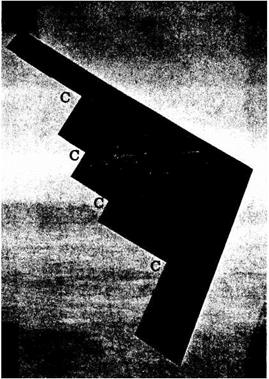Parallel-Line Planform Issues
The Northrop B-2 planform strongly distorts from the ideal the additional span load distributions, or the span loadings due to symmetric angle of attack and to rolling. Each planform internal corner, marked “C” in Figure 22.2, produces a sharp local peak in the additional span loading, as do the triangle-shaped wing tips. Premature stalling can be expected in the vicinity of the corners at high angles of attack and at high rolling velocities.
The resultant nonlinearity in the variation of lift with angle of attack at high angles is not in itself a stability and control problem. However, the yawing and rolling moment due to rolling derivatives C„p and Clp, normally negative in sign, become positive at combined high angle-of-attack and rolling velocity values. This problem is countered in the B-2 with an angle-of-attack limiter and with artificial stability increments that are tailored to Cnp and Cip values below the angle-of-attack limits.
|
Figure 22.2 Internal sharp corners, marked “C” on the Northrop B-2 bomber planform. These corners, the result of the stealth parallel-line planform, produce sharp local peaks in the wing’s additional spanload distribution. Premature stalling can be expected in the vicinity of the corners at high angles of attack and rolling velocities. |
A second B-2 stability and control issue is the elimination of vertical tails, requiring split ailerons to supply yawing moments in response to pilot and autopilot inputs. The split ailerons act as differential drag devices. The brake drag, and hence yawing moment, is nonlinear with brake opening, requiring further tailoring to produce predictable control moments.
As with all isolated sweptback wings, the B-2 has an inherent low level of positive static directional stability. However, the sweptback hinge lines of the split ailerons result in directional instability whenever the brakes are opened symmetrically at large angles, as an airspeed-control device. The open brakes themselves act as low-aspect-ratio wings, with lift components that produce destabilizing yawing moments when the whole wing is yawed to the airstream. The speed brakes are opened at landing approach airspeeds, putting an additional requirement on the logic that provides artificial directional stability at low airspeeds.
In addition to a very small level of inherent static directional stability, the B-2’s all-wing shape has next to no side force derivative in sideslip, or Cyf>. This creates a flight instrument problem, in that the normal ball-bank component of the turn and slip instrument cannot function as an indication of airplane sideslip. The standard ball-bank component is a lateral accelerometer, calibrated to produce one ball width at a tilt angle of 4.5 degrees, or a lateral acceleration of 0.08 g, in level flight. With virtually no side force developed in sideslip, there is no lateral acceleration to displace the ball. This instrumentation problem is aside from flight dynamics problems that occur with essentially zero Cyf>.
The Northrop B-2 wasthe very first parallel-planform configuration to be built. Engineers who were willing to talk about its development concede that there were some unpleasant stability and control surprises. Radar signature considerations probably rule out alleviation of distortions in span load by local wing twist for future applications. Correction for undesirable (positive in sign) values of C„p by artificial stability increments is of course available with sophisticated digital flight control systems, but the amount of correction available is limited for configurations without vertical tails. This is because the rudder power, or ability to generate yawing moments, is small for split aileron controls as compared with conventional vertical tail surfaces.












